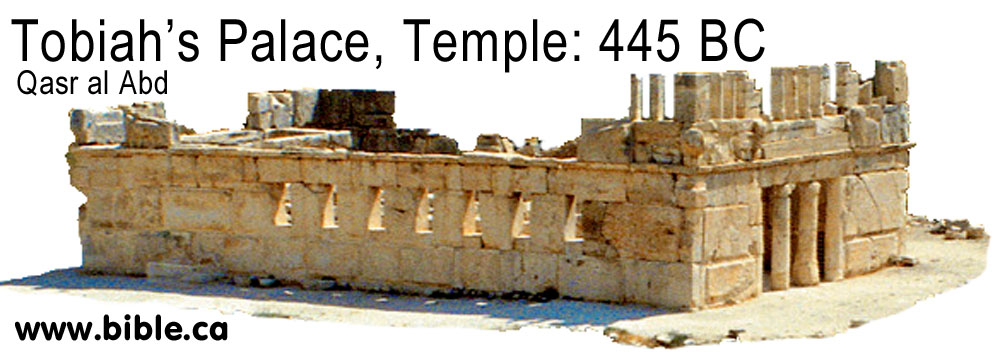Tobiah the Ammonite
Temple and Palace in Jordan
Qasr al Abd (near Iraq al Amir)
445 BC
Introduction:
1. Tobiah was the governor of Ammon, a high ranking official appointed by the Perians of the transjordan Ammonites when Nehemiah was rebuilding Jerusalem after returning from Babylonian captivity in 445 BC.
a. Do not confuse this archeological site with the Tobias (200 BC), the grandfather of Hyrcanus: 2 Macc 3:11. This man was a prominent and wealthy Jew of the Maccabean period, not an Ammonite.
2. Tobiah was one two central figures who, mocked, harassed, intimidated and opposed the rebuilding of Jerusalem: "When Sanballat the Horonite and Tobiah the Ammonite official heard about it, it was very displeasing to them that someone had come to seek the welfare of the sons of Israel." Nehemiah 2:10
3. There are three remarkable phases of Tobiah's life:
a. Opposition to the rebuilding of the temple.
b. Joining in worshipping and running the temple.
c. When he was thrown out of the temple, he crossed the Jordan and built his own temple and palace at
A. What the Bible says about Tobiah:
- "the sons of Delaiah, the sons of Tobiah, the sons of Nekoda, 652." Ezra 2:60
- "When Sanballat the Horonite and Tobiah the Ammonite official heard about it, it was very displeasing to them that someone had come to seek the welfare of the sons of Israel." Nehemiah 2:10
- "But when Sanballat the Horonite and Tobiah the Ammonite official, and Geshem the Arab heard it, they mocked us and despised us and said, "What is this thing you are doing? Are you rebelling against the king?"" Nehemiah 2:19
- "Now Tobiah the Ammonite was near him and he said, "Even what they are building—if a fox should jump on it, he would break their stone wall down!"" Nehemiah 4:3
- "Now when Sanballat, Tobiah, the Arabs, the Ammonites and the Ashdodites heard that the repair of the walls of Jerusalem went on, and that the breaches began to be closed, they were very angry." Nehemiah 4:7
- " Now when it was reported to Sanballat, Tobiah, to Geshem the Arab and to the rest of our enemies that I had rebuilt the wall, and that no breach remained in it, although at that time I had not set up the doors in the gates," Nehemiah 6:1
- "Then I perceived that surely God had not sent him, but he uttered his prophecy against me because Tobiah and Sanballat had hired him." Nehemiah 6:12
- "Remember, O my God, Tobiah and Sanballat according to these works of theirs, and also Noadiah the prophetess and the rest of the prophets who were trying to frighten me." Nehemiah 6:14
- "Also in those days many letters went from the nobles of Judah to Tobiah, and Tobiah's letters came to them." Nehemiah 6:17
- "Moreover, they were speaking about his good deeds in my presence and reported my words to him. Then Tobiah sent letters to frighten me." Nehemiah 6:19
- "the sons of Delaiah, the sons of Tobiah, the sons of Nekoda, 642." Nehemiah 7:62
- " Now prior to this, Eliashib the priest, who was appointed over the chambers of the house of our God, being related to Tobiah," Nehemiah 13:4
- "and I came to Jerusalem and learned about the evil that Eliashib had done for Tobiah, by preparing a room for him in the courts of the house of God." Nehemiah 13:7
- "It was very displeasing to me, so I threw all of Tobiah's household goods out of the room." Nehemiah 13:8
B. The Samaritans chose Mt. Gerizim after the Babylonian captivity in 516 BC
- After Judah returned from exile, the idol worshipping Samaritans were confronted with a zealous and repentant group of Hebrews who immediately started rebuilding Jerusalem and the Temple. Judah had learned in exile what the Samaritans never did: Follow the word of God exactly as it is written as a blueprint. Many churches today are very "Samaritan like" in that they teach both the Gospel and things that had their origin in the human mind. The biggest false doctrine floating around churches today is: "Doctrine doesn't matter."
- Tobiah (an Ammonite) and the men of Samarita mocked and opposed Nehemiah's efforts to rebuild Jerusalem: "When Sanballat the Horonite and Tobiah the Ammonite official heard about it, it was very displeasing to them that someone had come to seek the welfare of the sons of Israel." Nehemiah 2:10 "He spoke in the presence of his brothers and the wealthy men of Samaria and said, "What are these feeble Jews doing? Are they going to restore it for themselves? Can they offer sacrifices? Can they finish in a day? Can they revive the stones from the dusty rubble even the burned ones?" Now Tobiah the Ammonite was near him and he said, "Even what they are building-if a fox should jump on it, he would break their stone wall down!"" Nehemiah 4:2-3
- About 445 BC, When the Jews succeeded in completing
rebuilding Jerusalem, Tobiah went off in a huff, and built his own temple
and royal palace, which was located transjordan in his native homeland of
the Ammonites. The
temple can be seen today with amazing full size rock carved lions all the
way around the top of the temple. There are also lions at ground level.
One is pictured below. There are many "house of David" symbols
including lily flowers and capitals of the same style that David used.
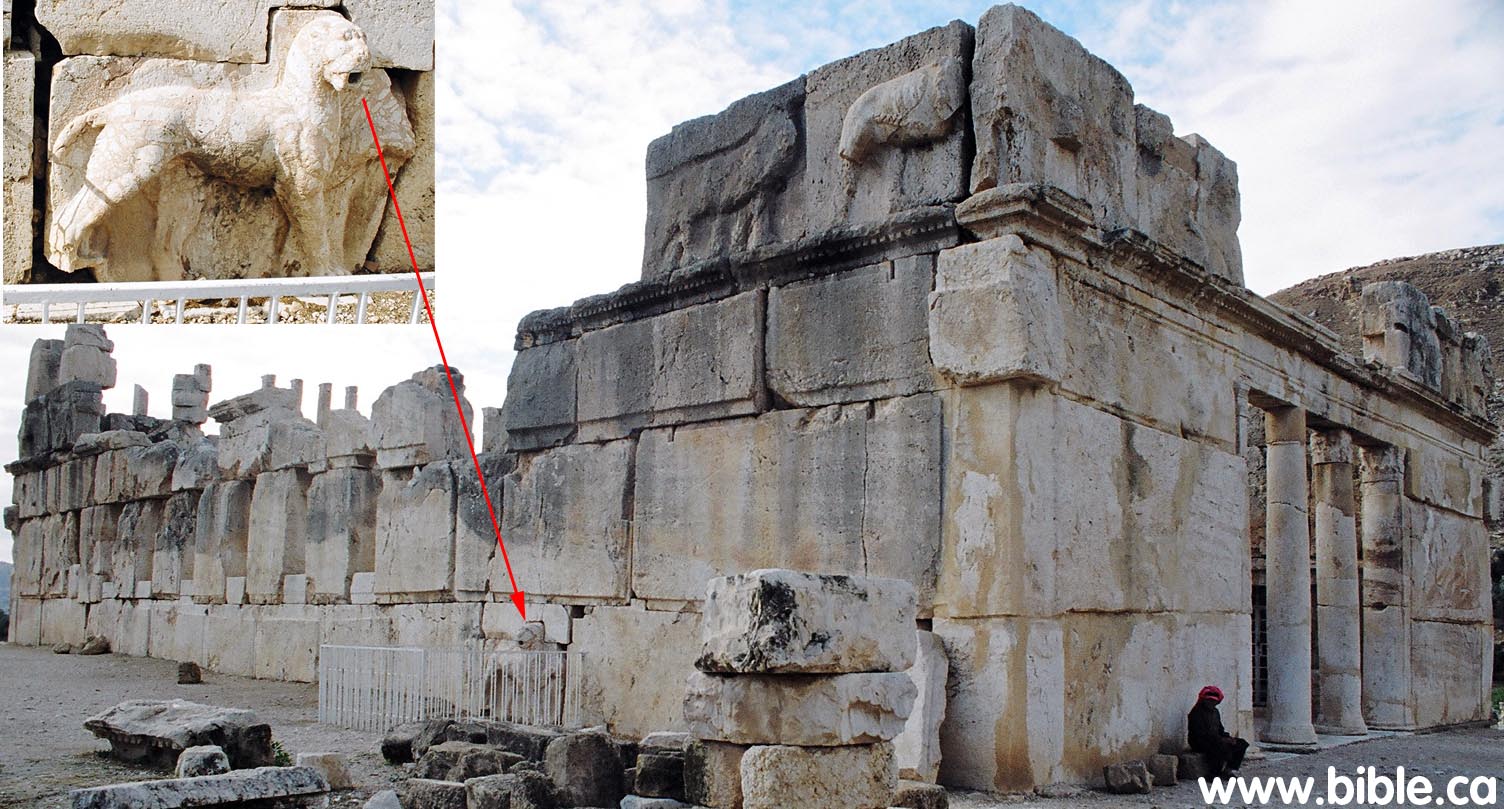
- Here is one of the many lions that adorn Tobiah's temple.
This is of a lioness with a nursing cub.
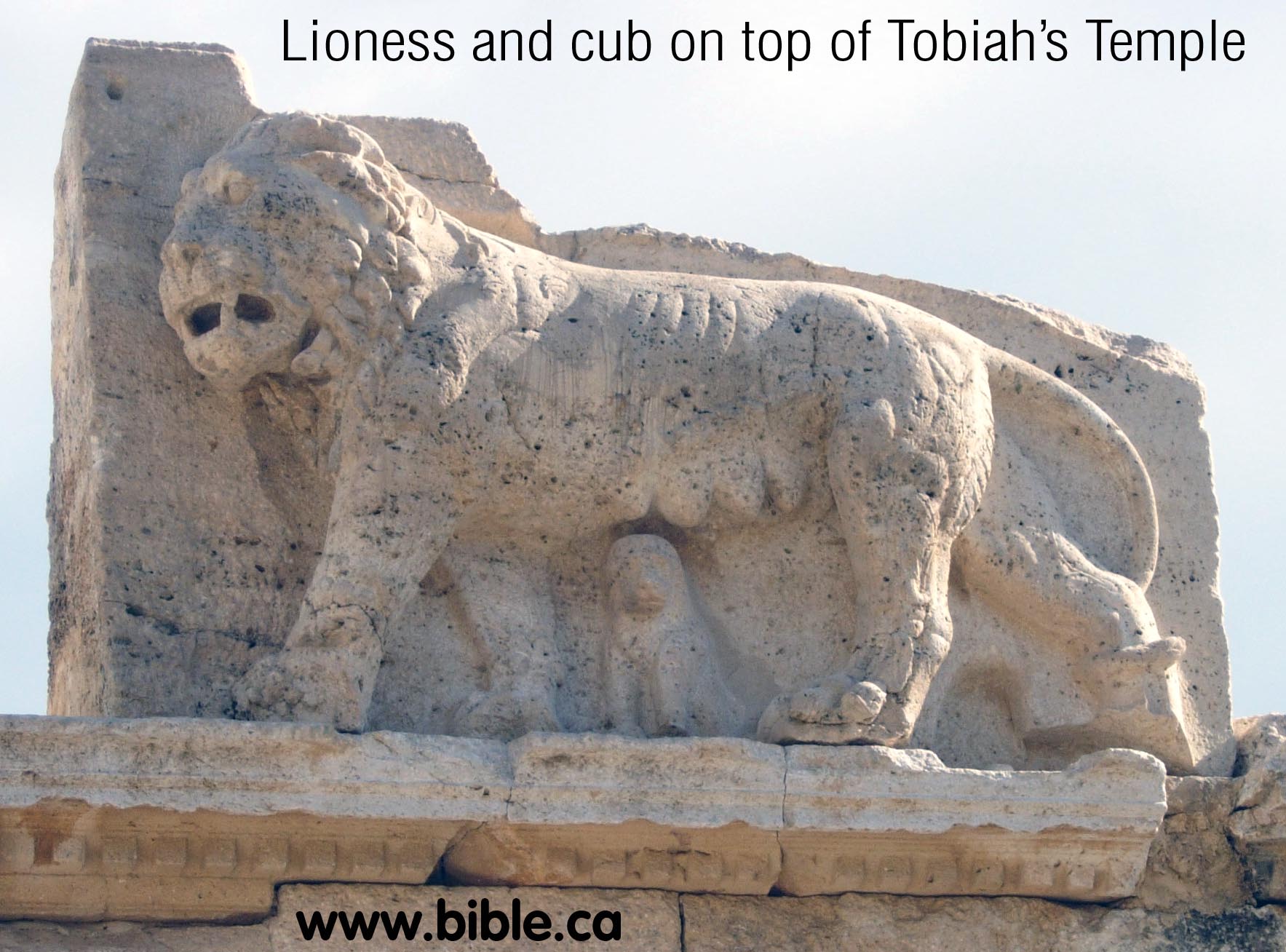
C. Tobiah's palace:
- Tobiah's royal palace was built about 2 kms away up in the
side of a rock cliff. It was a massive structure and twice an inscription
can be found on the palace walls that identify it as "Tobiah".
Here is the first "Tobiah" inscription right of the door that is
cut out of solid rock.
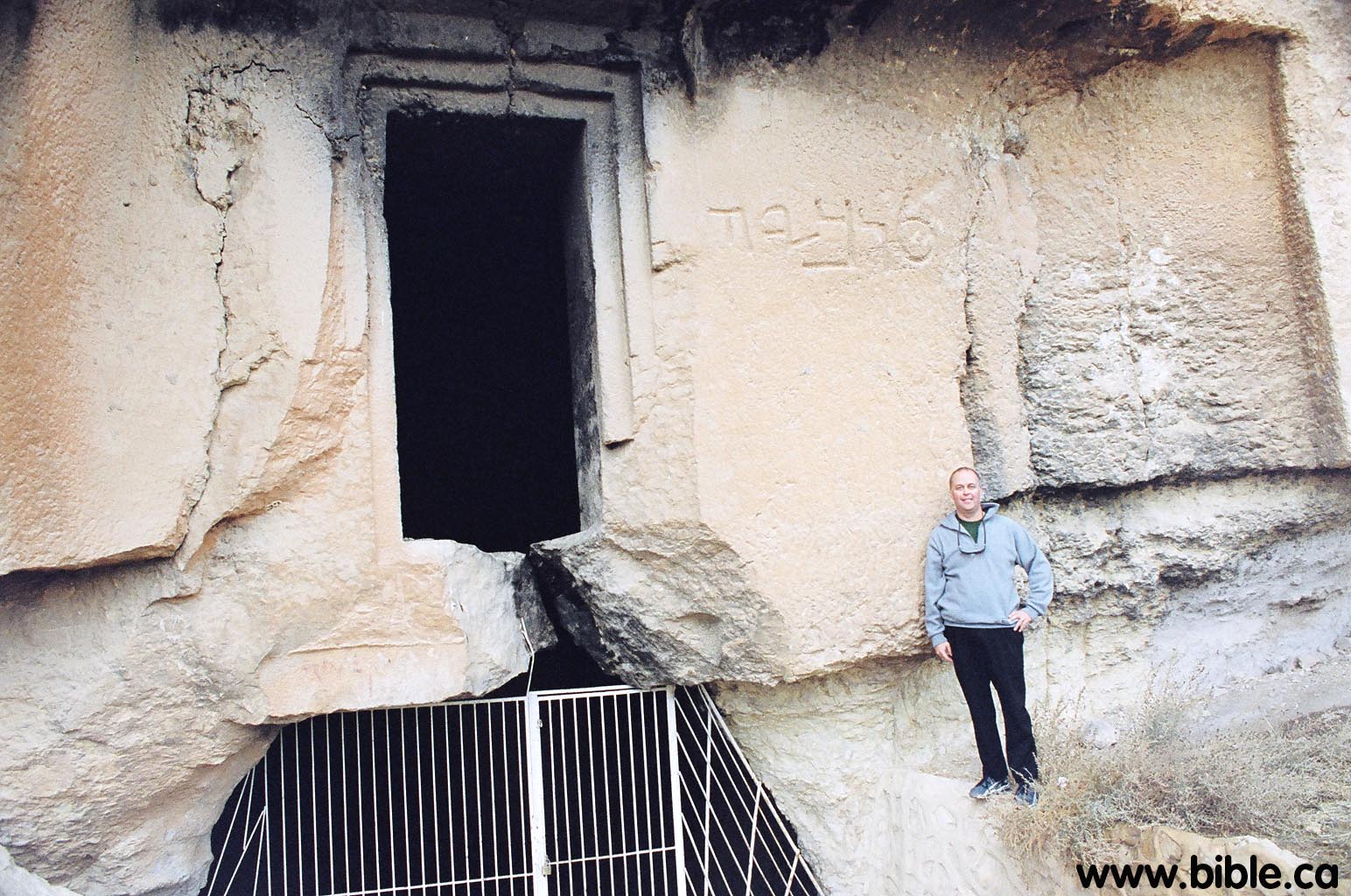
- Here is a close up of the second of two "Tobiah"
inscriptions on the palace walls:
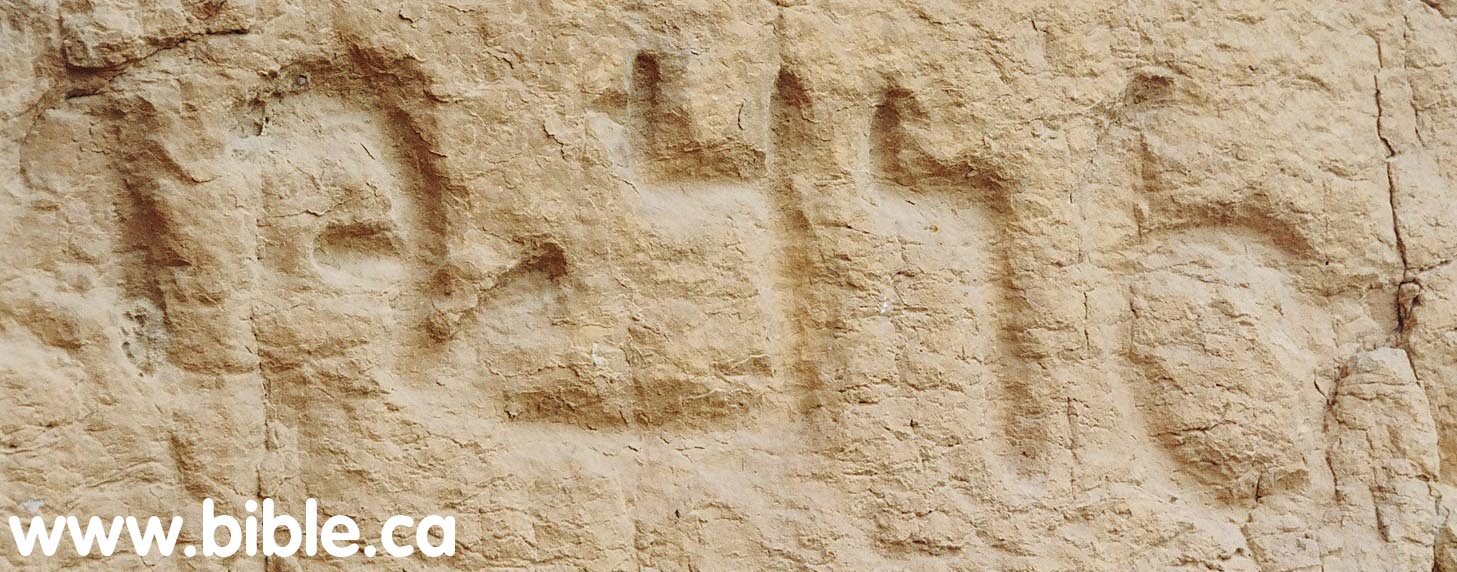
D. The lily flower symbol:
- Lily decorations were used by David and Solomon in the temple: "It was a handbreadth thick, and its brim was made like the brim of a cup, as a lily blossom; it could hold two thousand baths." 1 Kings 7:26
- The lily, "shoshanah", appears on the coins of
Johanan Hyrcanus and Alexander Jannaeus.
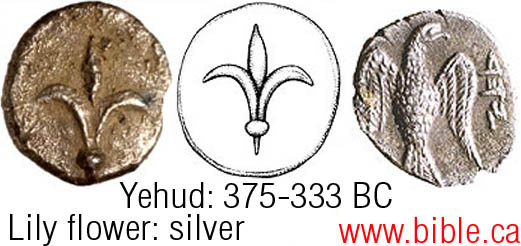
It was regarded as the choicest among the flowers. It graced the capitals of the two main pillars, Jachin and Boaz, which stood at the entrance to the sanctuary of the Temple. The lily likewise decorated other objects of the holy place. One of the most elaborate gates of the sacred enclosure which opened toward the east and the rising sun, was called the Eastern Gate. The top of this gate was beautified with a sculptured form which was called Shushan ha Birah- the castle Susa (Shushan). It might have been so called because of the ornament of lilies on it. Long after the destruction of the Temple, when traditions were forgotten, and explanations were sought to things unexplainable, political interpretations were given to this supposedly strange architectural feature. The Amora Hisda suggested the form of the Shushan Birah was to serve as a reminder that the Jews returned from Persia (Babylon). Yizhak b. Abdimi intimated that the Shushan was constructed by the Persian government to emphasize Jewish dependence and to insure loyalty of the Jews to that power. Of the other sacred objects in the Temple, lilies adorned the rim of the brazen sea or laver designed for the washing of the priests before they performed their divine duty. This laver which stood south-west of the monumental steps that led to the sanctuary, and near the altar, symbolized the pure water of which the heavens were supposed to be composed. The sacred candelabrum within the sanctuary, perhaps representing the solar system, was adorned, according to the Bible, with flowers, and according to later Jewish tradition these flowers were lilies. The lily represented the world of flowers. It symbolized human virtues such as righteousness, purity and chastity. One of these virtues has been befittingly illustrated by the character of the apocryphal work, "Book of Susanna" (Shoshanah). In the words of the prophet Hosea, the lily became the flower symbol of Israel: 'I will be as the dew unto Israel, he shall blossom as the lily;' and the lily was also allegorically referred to in the Song of Songs, and as a favorite simile later in Hebrew poetry. The lily, shoshanah, is used generically, as it embraced other related flowers. Lilies had grown on hills and in the field. The choicest of lilies were those that grew in the valleys, in the proximity of water. Perah - flower in the Bible - is often rendered shoshanah - lily in the Targum. This flower was considered to be one that bloomed rapidly, therefore it became a symbol of fertility. It constituted one of the many kinds of spices used in ancient times. The musical instrument shoshan or shushan mentioned in the Psalms, evidently had the shape of the lily, as is seen from the harps on the coins of the Second Revolt, and also resembled the shape of the lily on the coins of Johann and Alexander Jannaeus. Strange as it may seem, the lily on the Jewish coins resembles the Rhodus flower - the rose. This seeming inaccuracy is explained by the generic term of shoshan which might have included such flowers as the lotus and even the rose. In fact, the Midrash contains a few passages which speak of a soft lily, and the excellent of this kind is the lily of the valley, paralleling the rose of the valley. Besides these allusions, the Midrash specifically mentions a shoshanah shel wered -a lily-rose - which grows in orchards, this species of lily-rose being the symbol of Israel. It is evident that when the lily was considered by the Maccabean rulers as one of the symbols to be reproduced on coins, this aesthetic choice, emblematic of Israel, and known to others through the Rhodus flower, influenced the selection of this particular kind. (Paul Romanof, The Jewish Quarterly Review, New Series, Jan 1944 AD) - At Tobiah's Temple, there are many lily flower decorations
in fine detail:
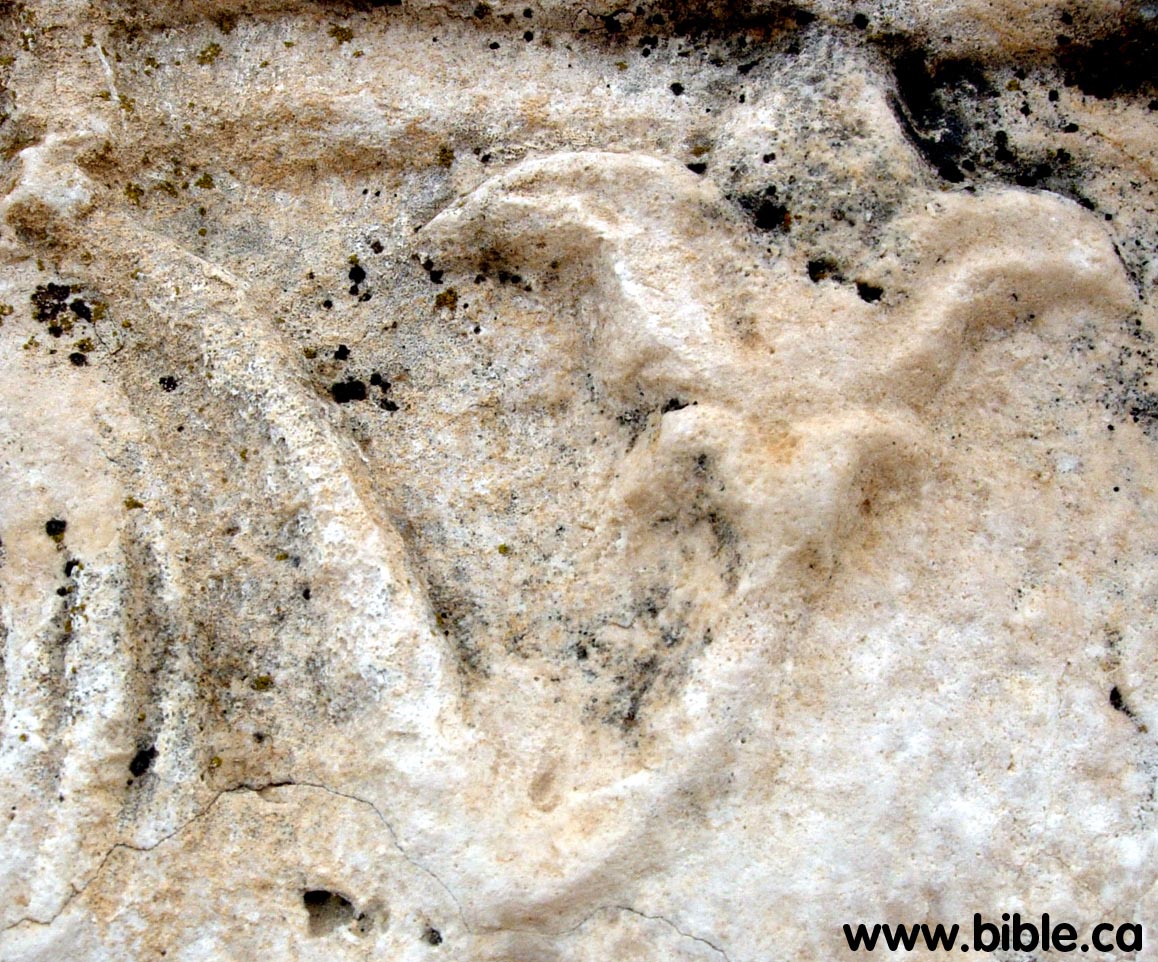
- The lilies are also found on many capitals and large
stones:
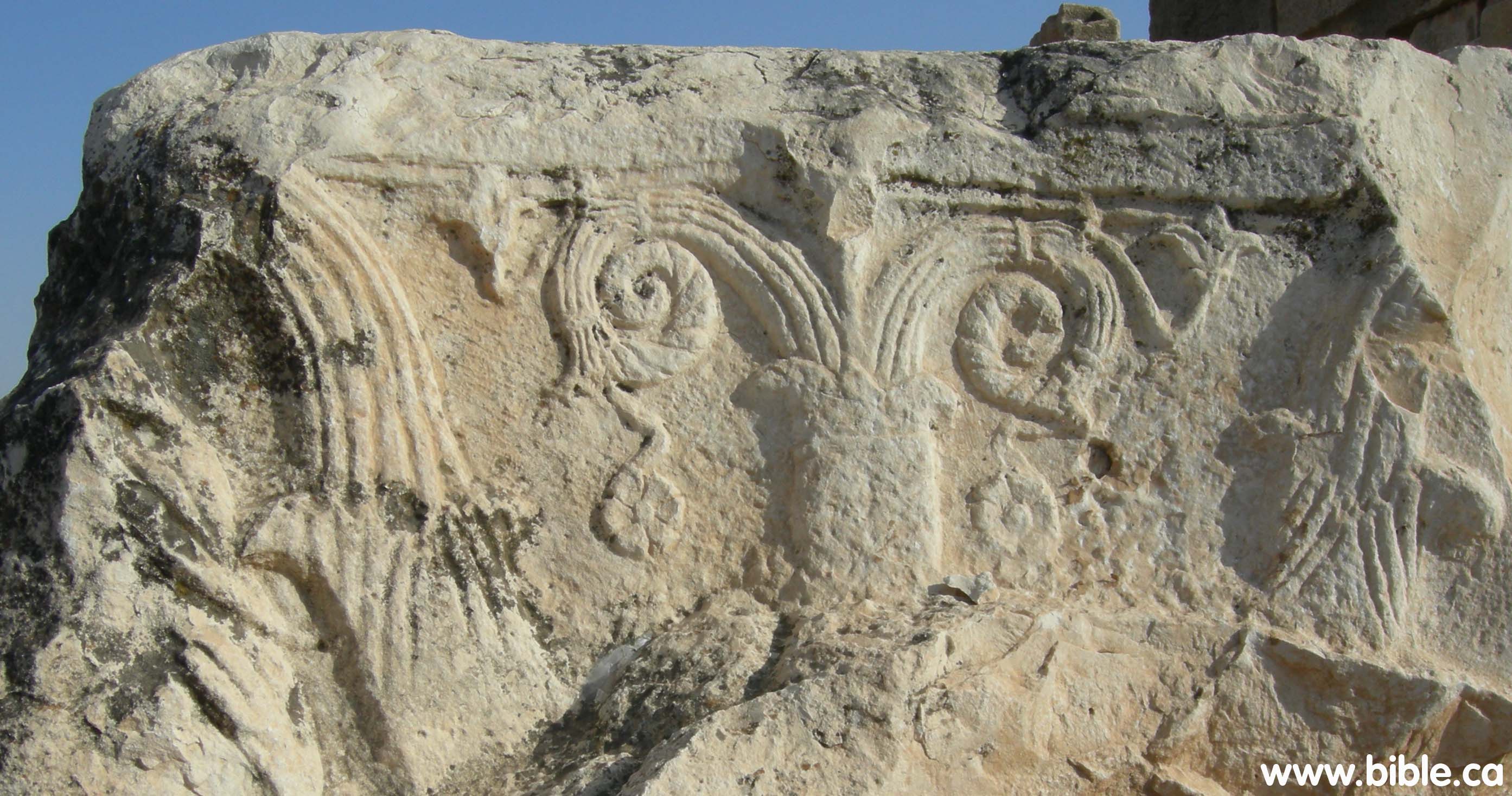
E. The Temple in Jerusalem vs. Tobiah's temple
- The Tobiah temple is absolutely amazing. It has been reconstructed on site and is almost entirely intact. The way the temple was built made it easy to fit the hundreds of stones back together is certainty.
- The Tobiah temple was built at the exact same time as the walls in Jerusalem were built my Nehemiah.
- The Tobiah temple gives us an architectural insight into what the Jerusalem temple would have looked like in size, design and decorations.
By Steve Rudd: Contact the author for comments, input or corrections.
